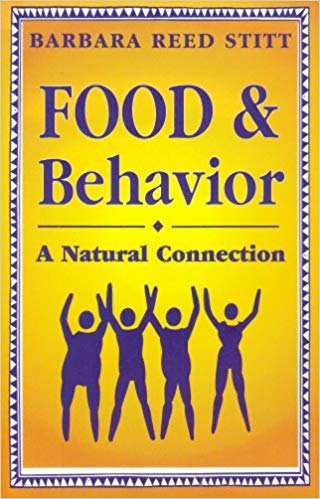 Barbara Reed Stitt wrote Food and Behavior to document her work with thousands of probationers and her success in changing their diets – and their lives. Her approach used whole, fresh, real foods, which corrected brain functions and behavior allowing them to become contributing members of society. Stitt also noted that many going into prison have an even worse diet while incarcerated than the fast foods they were eating before prison. These people come out with more behavioral issues and a further damaged brain. (Stitt, 2004)
Barbara Reed Stitt wrote Food and Behavior to document her work with thousands of probationers and her success in changing their diets – and their lives. Her approach used whole, fresh, real foods, which corrected brain functions and behavior allowing them to become contributing members of society. Stitt also noted that many going into prison have an even worse diet while incarcerated than the fast foods they were eating before prison. These people come out with more behavioral issues and a further damaged brain. (Stitt, 2004)
The background of Stitt’s story is important. She was chief probation officer for the Cuyahoga Falls Municipal Court and in 1963 became seriously ill. Her physicians could not help her. She discovered a book by Gaylord Hauser that changed her life. After consuming only “live” foods, as Gaylord proposed and healing herself, Stitt realized that her probationers were junk food addicts, as she had been, consuming 50 to 150 teaspoons of sugar a day; many were alcoholics as well. Soon the judges were sending probationers to her saying ‘eat what Barbara tells you or I’ll put you in jail.’ Stitt had remarkable success with thousands of people and a 20% recidivism rate, which is extraordinary. On average, 67% of ex-prisoners are re-arrested and 51% go back to jail. (Stitt, 2004)
Stitt is not the only one to say that food matters and prisoners’ meals are important. In 1978, Alex Schauss was one of the first to show that an improved diet could decrease recidivism. He studied a cohort of 102 probationers separated into four groups. Recidivism data was collected for a year. The two groups that received either nutrition counseling or nutrition education had significantly lower re-arrest rates. Schauss’s approach used the orthomolecular diet that Barbara Reed Stitt employed in her work. (Schauss, 1978)
 Emma Gordon, the author of Broccoli or Broken Windows? The relationship between antisocial behavior and a nutrient deficient diet looked at the difference in diets from the same town in England and compared the diets of those who were arrested for anti-social behavior (ASB) and a same-aged control group. The daily food consumption in the ASB adolescents showed a lack of nutrients, especially zinc, iron, B vitamins and protein in the first 3 years of life. The study concluded that this lack caused aggressive and anti-social behavior later in their lives. By the age of 8, the ASB children were more hyperactive and aggressive; by 11, the same kids were displaying delinquent tendencies and by 17 were externalizing behavioral problems leading to adult criminal activities. (Gordon, 2011)
Emma Gordon, the author of Broccoli or Broken Windows? The relationship between antisocial behavior and a nutrient deficient diet looked at the difference in diets from the same town in England and compared the diets of those who were arrested for anti-social behavior (ASB) and a same-aged control group. The daily food consumption in the ASB adolescents showed a lack of nutrients, especially zinc, iron, B vitamins and protein in the first 3 years of life. The study concluded that this lack caused aggressive and anti-social behavior later in their lives. By the age of 8, the ASB children were more hyperactive and aggressive; by 11, the same kids were displaying delinquent tendencies and by 17 were externalizing behavioral problems leading to adult criminal activities. (Gordon, 2011)
The British Journal of Psychiatry published a randomized control trial study in a prison with 231 prisoners. One group received vitamins, minerals, and essential fatty acids in supplement form; the control group had look-alike placebos. There was a statistically significant reduction in both major and minor infractions during the course of the 9-month study. The baseline data of the two groups was the same in terms of the number of infractions. Infractions were reduced by 35.1% compared to the baseline data and 26.3% compared to the placebo group. Clearly changing diet or nutrient intakes in order to reduce anti-social and violent behavior in prisons has excellent implications. (Gesch, Hammond, Hampson, Eves, & Crowder, 2002)
The cohort study, Confectionery consumption in childhood and adult violence, followed 17,415 from birth to 42. Overall, 69% of the participants convicted for a violent crime by age 34 had reported that they had eaten candy or other sugary foods nearly every day in childhood. Only 42% of the non-violent participants reported having eaten candy or sugary food daily as a child. This is a statistically significant result. The researchers surveyed each participant 7 times from ages 5 to 42, asking about diet, sugar intake, and behavior. The authors concluded that eating sugary foods daily as a child predicts perpetration of violence in adulthood, even when taking into other factors such as economics and personality traits. (Moore, Carter, & van Goozen, 2009)
The above studies are a good foundation for understanding how food can have profound effects on behavior to the point that it can lead to violent crimes.
References:
Gesch, C. B., Hammond, S. M., Hampson, S. E., Eves, A., & Crowder, M. J. (2002). Influence of supplementary vitamins, minerals and essential fatty acids on the antisocial behavior of young adult prisoners: Randomized, placebo-controlled trial. The British Journal of Psychiatry. 181, 22-28. Retrieved from: https://bjp.rcpsych.org/content/181/1/22.long
Gordon, E. (2011). Broccoli or Broken Windows? The relationship between anti social behavior and a nutrient deficient diet. Internet Journal of Criminology. ISSN 2045-6743 (Online). Retrieved from: https://www.internetjournalofcriminology.com/Gordon_Broccoli_or_Broken_Windows_IJC_September_2011.pdf
Moore, S. C., Carter, L. M., & van Goozen, S. (2009). Confectionery consumption in childhood and adult violence. The British Journal of Psychiatry. 195, 366-7. Retrieved from: https://bjp.rcpsych.org/content/195/4/366.long
Schauss, A. G. (1978). Differential outcomes among probationers through the use of orthomolecular approaches and casework/counseling. National Criminal Justice Reference Service. Retrieved from: https://www.ncjrs.gov/App/Publications/abstract.aspx?ID=54024
Stitt, B. R. (2004). Food and Behavior. Manitowoc, WI: Natural Press
